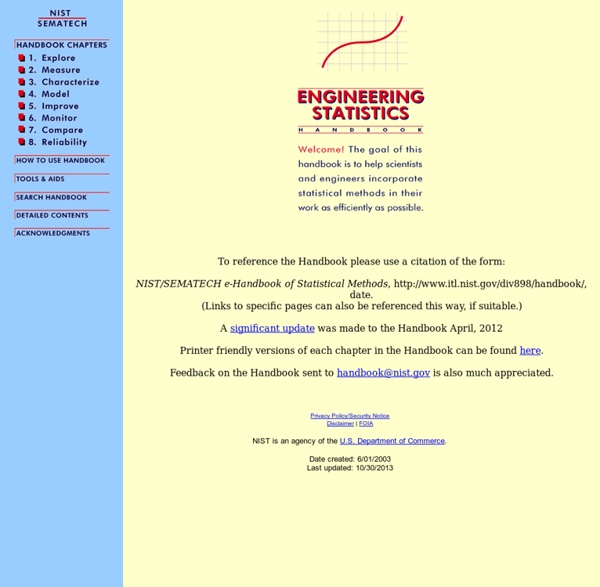



Data Evaluation and Comparisons Introduction → Presentation of data comparison techniques, and the steps for evaluating set of data Hypotheses → Definition of statistical hypotheses about datasets t-tests → t-tests for comparing the means of different datasets One- & Two-tailed tests → Testing whether a mean is greater than, less than, or not equal to, another mean F-test → Testing differences between standard deviations of datasets, for comparing precision You have now seen how to generate a calibration curve for an instrument from a set of linear data, and then use the curve to determine the concentration of an unknown sample from a measured signal. Let's say you just taken a number of concentration readings from a sample of unknown concentration, and you want to determine whether the difference between your measured value and the stated value is statistically significant, or simply do to a random error. There are a few steps for evaluating a dataset or comparing multiple sets of data. © Dr.
Links: Allchem/IQ-USP « Pesquisas de Química Estruturando: Materiais e informações na WWW-Internet Selecionar da imensidão de informações sobre química e ciências afins existente na WWW-Internet, materiais de qualidade e que atendam ao amplo espectro de consulentes da AllChemy (de estudantes e profissionais de ensino médio e superior a pesquisadores e professores com pós-doutorado), este é o desafio que enfrentamos nesta página. Auxilie-nos a ampliar a lista dos melhores links, mandando indicações e críticas por e-mail. Química ExpoChemy – Exposição Virtual de Produtos Químicos, Reagentes, Equipamentos (AllChemy) Exposição e Base de Dados mantida pela AllChemy, que permite localizar rapidamente fabricantes ou fornecedores de cerca de uma centena de milhares de produtos químicos, reagentes, serviços, equipamentos, materiais, consultorias, etc…. Química na Internet (link @ Martindale, em inglês) Tabelas Periódicas Tabela periódica com algumas propriedades de cada elemento (link @ Pitágoras)WebElements (link @ Univ. Estruturas Químicas
Physical Reference Data Elemental Data Index Provides access to the holdings of NIST Physical Measurement Laboratory online data organized by element. Periodic Table: Atomic Properties of the Elements Contains NIST critically-evaluated data on atomic properties of the elements. Suitable for high-resolution color printing for desk or wall-chart display. Contains values of the fundamental physical constants and a related bibliographic database. Contains databases for energy levels, wavelengths, and transition probabilities for atoms and ions and related bibliographic databases. Includes databases containing spectroscopic data for small molecules, hydrocarbons, and interstellar molecules. Contains databases on thermophysical properties of gases, electron-impact cross sections (of atoms & molecules), potential energy surfaces of group II dimers, and atomic weights and isotopic compositions. Contains databases on the interaction of x-rays and gamma-rays with elements and compounds.
Paginas :: Programa de Pós-Graduação em Ciência Ambiental Voltar Para Inscrição no Curso de Mestrado, o candidato deve apresentar, além de toda documentação prevista em Edital, comprovação de Proficiência em Língua Inglesa, conforme as NORMAS DO PROGRAMA e, aval sobre o Projeto de Pesquisa de um dos orientadores credenciados no programa. Esse aval significa que, caso o aluno ingresse no programa, este docente irá orientado-lo durante o seu curso. A Seleção se dá em duas etapas, sendo a primeira uma Prova Escrita, com Bibliografia indicada em Edital de Seleção e, a segunda consiste na Análise do Projeto de Pesquisa e Arguição do Candidato. As incrições são anuais e ocorrem em período pré estabelecido no mês de setembro. A Seleção para os Cursos de Doutorado e Doutorado Direto é realizada no Sistema de de Fluxo Contínuo, em que o aluno pode se inscrever a qualquer momento, desde que reúna as condições previstas no EDITAL DE SELEÇÃO . A Seleção se dá por meio da Análise do Projeto de Pesquisa e Arguição do Candidato. Ficha de Inscrição (Versão Word)
Using Your Calculator In this section you will be asked to explore the functionality of your scientific calculator, and to use your calculator to solve some simple problems. Pay special attention to the order of entry of the key strokes. It might be helpful to consult the operator's manual that came with your calculator if you have any specific questions on how your calculator works. In the previous section, we reviewed a little about numbers and representations, and if you used your scientific calculator to repeat the exercises in the Working with Numbers section, you probably learned a little about where certain buttons were on your calculator. It is very important that you become very familiar YOUR calculator, so that you can use it as a helpful tool in solving a variety of problems; and it helps to know how to use the calculator before you are under the time pressure of a test! What Works, What Doesn't Why? Depending on the application, this problem becomes clear very quickly. Enter Avogadro's Number.
World of Chemistry Sign In | My Account | HMHEducation | eServices | Online Store | Contact Us | FAQ Find another book Search: World of Chemistry Activities Animated Chemistry Assessment Chapter Quizzes Research Center Science Daily: News & Articles in Science, Health, Environment & Technology